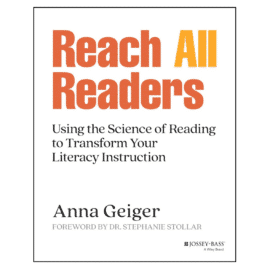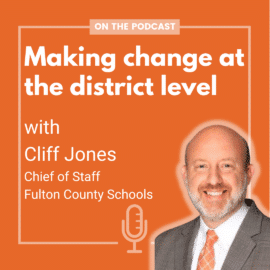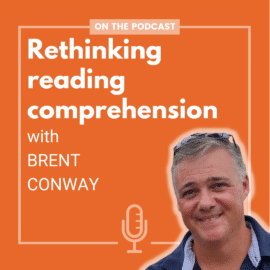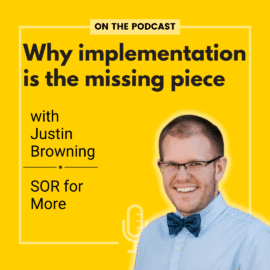
TRT Podcast#69: What you need to know about Orton-Gillingham
What IS Orton-Gillingham anyway? Is it backed by research? What do critics have to say? We’ll answer these questions and more in today’s episode.
Listen to the episode here
Full episode transcript
A complete look at IMSE’s OG Method
For brevity’s sake, I did not include all lesson components in the podcast episode.
Get the full IMSE lesson break-down here.
Related resources
- What Does Science Say about Orton-Gillingham Interventions? article from the Reading League journal by Emily Solari, et. al.
- What is the Orton-Gillingham Approach? blog post from The Orton-Gillingham Academy
- Orton-Gillingham training from IMSE
YOU’LL LOVE THIS PRACTICAL BOOK!

Looking for an easy-to-read guide to help you reach all readers? If you teach kindergarten through third grade, this is the book for you. Get practical ideas and lesson plan templates that you can implement tomorrow!








Gina Biats
Thank you for another excellent podcast. I always learn a lot from listening to them.
Anna Geiger
Thank you so much, Gina!
MG
We have a late dyslexia dx (gr 6) for one kiddo as he is so bright he’s been compensating for years. I’ve followed you for years now, and came looking for your take on OG as I knew you had been on a professional journey with all this…but couldn’t quite remember the content! Appreciate the integrity of sharing your whole journey on the science behind reading, and that you aren’t claiming OG is the only way. Knowing what some of the potential drawbacks are helps me ensure kiddo is getting the best help he can, regardless of method.
Anna Geiger
Thank you for your feedback! May you find the right support for your son – with a supportive parent on his side, I know he’ll be successful!
Denise
I appreciate your efforts in providing more information regarding OG, however, this is an uninformed opinion riddled with false statements that will lead to massive misconceptions that are incredibly misleading to those seeking facts and furthermore detrimental to the literacy skills of students.
To begin, the fact that this piece was written while you are in the process of obtaining your comprehensive certification through IMSE is highly concerning. Perhaps by completing the course in its entirety, engaging in IMSE’s stand alone phonological awareness training and then engaging in actually teaching it in both the whole/small group setting (not just in your home) could provide a more factual approach to your opinion. If that is not possible, perhaps your opinion should reiterate that you are using it in a home-school setting only.
You make reference to the idea that there are many organizations that say they provide “Orton- Gilingham” professional training, yet you are not explicit about which organizations you are criticizing throughout. This is misleading.
You make many false statements such as:
“It’s generally meant for being used in a one-on-one setting, but now it’s becoming more mainstream as we’re understanding that structured literacy is appropriate for all learners.” and “It’s a little more tricky when you’re working with a larger group.”
This is false. Orton Gillingham has been long associated with dyslexia. However, IMSE advocates for Orton Gillingham in all classrooms. It has for years. Simply put, it is not an intervention. IMSE is a research-based, scientific approach to reading and writing instruction to be used in Tier 1-3. It is direct, explicit, systematic, and sequential instruction that incorporates multi-sensory elements. IMSE’s program is based on the Science of Reading research. You can learn more about their advocacy for Science of Reading instruction for all here – https://imse.com/about-us/orton-gillingham-for-everyone/
You stated:
“Anything done one-on-one is going to be more effective probably than a whole-group approach, just because you’re able to be very diagnostic in that one-on-one setting. It’s a little more tricky when you’re working with a larger group. It also depends on the severity of the disability. …You have some kids who just have slight dyslexia, and that can really be handled by some structured literacy interventions, and you have kids who are severely dyslexic.”
This is false. Structured literacy is explicit, systematic, cumulative, multimodal, diagnostic, responsive and multilinguistic. Stating that 1:1 is more effective than whole group instruction is simply stating that you are less confident in the whole group setting. You are also indicating that only students with slight dyslexia will benefit from structured literacy. IMSE Impact Structured Literacy Programs are IDA accredited (International Dyslexia Association) (https://dyslexiaida.org/accredited-teaching-training-programs/) and are delivered by instructors who bring unmatched experience in literacy education to each course session. This kind of instruction is impactful for all students and critical for those with dyslexia of all degrees in all three tiers of instruction.
You stated:
“Finally, it’s hard to measure the efficacy of Orton-Gillingham because we don’t know what’s happening in the rest of the day.” …However, one specific piece of Orton-Gillingham that research has not proven to be making any kind of difference is the multisensory approach.”
This is false. You are quick to cite information placing doubt in the effectiveness of structured literacy, however you don’t provide any research that supports Orton-Gillingham and the multisensory approach. There are many. I encourage you to reach out to Science of Reading experts such as Dr. Mary Dahlgren, Dr. Louisa Moats, Dr. Deb Glaser, Wiley Blevins, Dr. Maryanne Wolf and get their perspectives directly.
For example: “Teaching Reading in an Inner City School Through a Multisensory Teaching Approach” (Joshi, R.M., Dahlgren, M., & Boulware-Gooden, R., Annals of Dyslexia, Vol 52, 2002).
This research states regarding the use of OG based methods: “A number of studies have demonstrated that systematic, explicit, decoding instruction that emphasized synthetic phonics yielded better results than other instructional methods. …In clinical studies, this approach has been proven to be very effective in improving reading and spelling among children with literacy problems.” Conclusion: “The results of this study showed that first-grade children taught with the multisensory approach based on OG principles performed better on tests of phonological awareness, decoding, and reading comprehension than the control groups. It may, therefore, be concluded that the higher scores for children for the treatment groups may be attributed to the multisensory approach used.”
See also, “An Empirical First Look at the Effectiveness of IMSE’s Orton-Gillingham Approach (2017). This research indicates: “…current data strongly suggests that IMSE’s OG is extremely effective with emergent readers…results show the majority of students achieved perfect or near-perfect letter and sound recognition even if they started below their peers.”
You stated:
“Their lessons look something like this.”
Your explanation of the lesson structure dives into the 3 Part Drill, but is vague, misleading & misses the opportunity to share integral aspects of the lesson structures that make them powerful. The IMSE lesson structure is as follows:
Phonological Awareness
Three-Part Drill & Vowel Intensive
Teaching a New Phoneme/Rule (Multisensory/Dictation)
Decoding & Learning Centers (Syllabication/Fluency/Vocabulary)
Red Words
Oral Reading (Connected Text/Decodables)
Comprehension
You stated:
“That would be my criticism of Orton-Gillingham. It feels like there’s a lot of word-level activity, and not as much connected text opportunity. If you are spending a ton of time doing this long procedure for red words and doing syllable division practice and doing dictation, it can be hard to fit in reading connected text, and that’s the whole point!”
This is false. Learning to recognize syllable types trains the brain to break words into manageable chunks. This is critical. The lesson sequence is meant to be spread out between your settings and throughout the week. Your assumption that there are not many opportunities for connected text is interesting given that there is a decodable text provided to you by IMSE for each skill. Do students need a tremendous amount of time in accountable texts? Absolutely. We know from Wiley Blevins that we should aim for 50% of our lesson in controlled texts. Do these strategies take a considerable amount of consideration for time management and efficiency? Yes. They absolutely do, but so does general teaching.
I do truly believe that you had good intentions in this podcast. My concern however, is that as someone with a vast social media platform, you have a moral and ethical right to share truthful information with your followers. You have many that look to you for valid advice and knowledge. You have a responsibility to provide that. The literacy skills of children are at stake. I kindly request that you review your statements after both completing IMSE’s professional development and have experience teaching it both in whole group and small group. I encourage you to speak directly with Science of Reading experts as well as IMSE curriculum developers directly and get their responses prior to publishing your opinion.
Anna Geiger
Thank you for your feedback, Denise! My intent of this podcast episode was not to be overly critical of OG or IMSE; in fact, I have only spoken positively of IMSE to anyone who asks and definitely recommend their certification program. My goal instead was to help people get a general understanding of what OG is and to hear some common criticisms so they can dig further.
I take issue with your comment “uninformed opinion,” as I have done a great deal of study on this topic and only have about 6 weeks left of an 8 month online certification program. I do understand that IMSE is intended to be used with the whole class, which is what I was alluding to. I’m sorry if I was misleading by using the word “recently.”
I stand by this opinion: “Anything done one-on-one is probably going to be more effective than a whole-group approach.” When you have just one person’s needs to meet, you can be more targeted and certainly save time in materials management, which allows more time for instruction. I hope we can agree to disagree on this one, as I am certainly aware of (and a huge proponent of) the value of structured literacy’s explicit, systematic, cumulative, diagnostic, and responsive approach.
Everything I have read has about OG research has stated that the multi-sensory aspect has not been proven to make a difference. I’m not saying that it doesn’t; I would think that it would, but the most recent article I’ve read on the subject (Reading League Journal) stated this as well. I think more research needs to be done, and I definitely wouldn’t say that teachers should throw out the multi-sensory piece. I very much appreciate your article titles, and I will certainly look those up and print/study if there is no paywall.
I do follow and read works of Dahlgren, Moats, Glaser (I took her full course), Wiley Blevins (I’ve read and own all his books), and Dr. Wolf. Please don’t think that I’m shooting in the dark here. You claim my opinion is uninformed, but that’s simply not true. It may be different than yours, but it is not uninformed.
You are correct that I gave just a portion of OG’s overall lesson structure in the podcast. Perhaps that was an oversight on my part, but my goal wasn’t to break it down completely. I will look into giving some links to IMSE’s program in the show notes so that readers can learn more about the full program.
I am aware that IMSE provides decodable texts. I also know that doing syllable division and dictation take a great deal of time; in my experience, more time than it takes to read the decodable reader. I don’t want to question the value of those activities, as I do believe students need some way to divide words into syllables and I absolutely love dictation, but I would encourage teachers should make sure they make plenty of time for reading and re-reading decodable text. It was my intent to communicate that and apologize if that was not clear.
You mention a defense of syllable types, and I agree. I don’t recall criticizing that in the podcast, but again, I want to encourage teachers to make sure students have time to apply this explicit instruction within the context of actual books. In saying that I don’t intend to diminish the value of the skills work.
Yes, I do believe that I have a moral and ethical right to share truthful information, and that is what I feel I did in this episode, or I would not have published it. You may find it interesting to note that before I learned about structured literacy/science of reading, I had hundreds of balanced literacy resources on this website that I have since taken down and replaced with research-based materials.
I also think that I am entitled to personal opinions, which I shared as well. There is a large group of people in the science of reading community who do not believe that OG is the best approach. Personally I am pleased and impressed with what I’ve learned in my research and training, but it’s only fair to alert my listeners to the fact that there is another side of this issue.
Based on the other comments I’ve received, I don’t believe my other listeners took this as a negative criticism of OG. It was my goal to share both sides.
Thank you again for those article links!
Jenna Z.
Thank you for this terrific breakdown. My jaw dropped as I read the blurb Google provides when naming a site, stating that O.G. was developed before phonological knowledge was known about and used… since Gillingham/Stillman/Samuel & June Orton all hammered on the phonological approach.
Sometimes it takes a very deep dive to be able to get inside something that is not simply a program to review. Your reply is so informative it’s worth coming to this blog. I hope the Measured Mom appreciates your care.
Anna Geiger
I hope you also read my reply.
Kathy
Thank you for this podcast. I am constantly wondering about OG as I implement it this year with my 1st grade students. I do not belive that one intervention or litearcy program meets the needs of all students, but I gave it a try with all of my 1st grade groups because my school invested a lot of money in my training. After progress monitring weekly for a few months, I realized that it was not meant for everyone. I clearly saw that OG was not targeting the needs of all of my students. I also feel that too much time is spent swtiching between materials and when you only have 15-20 minutes to work with groups of students, too much instruciton time was lost with material management (I am a very organized person that made that quick, but in my opinion, we didn’t have time to lose). I am glad that you pointed out the recent metanalysis of OG interventions and also the fact that explicit and systematic instruction is key. Also, it’s important to notes, that targeted interventions directly linked to students’ needs have always been the most effective and many researchers support that. We often should question and wonder when we are implementing something new and use data to determine the effectiveness of our teaching. Thanks again for starting this conversation, it’s an important one to have.
Anna Geiger
Thanks so much for your feedback, Kathy! I’d love to know more about why you felt this approach wasn’t working for some of your students. I do agree that switching between materials can suck up a lot of lesson time; I’m just curious to know your other thoughts on the method.
Linda
I was just trained last summer and I really like O-G. It makes a lot of sense and the “cat” and “kite” rules for spelling! Why isn’t this rule being taught at universities? It is so helpful. Students don’t have to ask me if it should be a “c” or “k” because they know because of the vowel. I use the decodable books that come from IMSE. Those are very helpful. Overall, I really like the program when working with special education.
Gina
I learned the vowel rule when my school taught Saxon Phonics.
Anna Geiger
Thanks so much for your feedback, Linda! I agree that all of us need more training in the English language and phonics!
Rhonda
I have been using O/G for several years and I have found that the amount of rules can be overwhelming and time consuming. Rather than rules I tend to help them notice patterns that happen often. Red words also take a lot of time when they are all doing something slightly different from each other in my RtI groups. I have been making up a “red sentence” for 4-5 words and practice this sentence with the review section several lessons in a row. (eg. gave, live, father, Tuesday = He; He gave; He gave a; He gave a live; He gave a live spider; He gave a live spider to; He gave a live spider to; He gave a live spider to…… his father on Tuesday.) They would read it for fluency practice first and then they would write it to practice the spelling. This has been successful for my 2nd-4th grade students.
Anna Geiger
I’ve heard good things about that method for building fluency … I’ll have to try it! I do agree that all the rules can be too much for some kids. Noticing patterns is a good solution!
Lisa
I have been using OG for the past four years in my kindergarten class and I LOVE IT!!!! It is amazing how well my students learn to read and write!!1 They have so much more confidence!!! Like any program you adapt it to your class and the way you teach! I am so thrilled you are being trained!!! Lisa
Anna Geiger
This is wonderful to hear, Lisa! Thanks so much for sharing your experience! Are you using a particular program?
Mary B
Hi, Anna! I love reading your blog and following your journey! As a mom of a big family who home schooled for 12 years ( and then went back to college for a Literacy degree during which time I leaned almost nothing that was very useful 🙄), I was lucky enough to have a friend give me Romanda Spaulding’s book, The Writing Road to Reading. Ms. Spaulding was a student of Samuel Orton. In her approach the student is given phonograms and at the time of the initial instruction of the particular grapheme, the child learns all the common sounds it makes. For example, when shown -ch the child would make all three sounds (as in cheese, ache, chef) and if I remember correctly they are recited most common to least. What are your thoughts on how this differs from OG? I really liked that as we were reading and coming upon a less common sound for a spelling ( which can happen even if limiting the text complexity as in decodables ) I didn’t have to say, “Oh yeah that also days…” So words like “was” were decodable early on as they had learned alternate sounds for -a and -s. I found it super effective vs continually teaching new sound/spelling correspondences. Then as the students work their way through the Ayres List, each word is orthographically mapped in their note book. Thanks again for all you do! You are a true giver and each day is better and brighter because of dedicated, kind people like you!!!!
Mary B
That should be learned not leaned😂 Sorry…tiny iPhone keys!!!
Terri
Hi Mary I’d like to know Anna’s thoughts on that method also, and I am wondering what age were the students you were working. With this way? I’ve read The Logic Of English which says that this method may particularly help children who appreciate knowing the rules and don’t intuitively make the z sound in words like “is” and “was”. I’m working with a second grader and I think he could benefit from this kind of instruction.
Mary Bracy
Hi, Terri! I home schooled my first child from K-8th and then it varied with the rest. We used The Writing Road to Reading from K right through until the end of 3rd grade and maybe a little into 4th (I am a little cloudy because that particular student is now 32 with 2 kiddos haha). My school is now working with The Reading League to train all teachers in the Science of Reading and my home school experience really aligns with everything being taught! The piece that was missing from the “Spaulding Method” and I believe it was missing from OG until fairly recently was the phonemic awareness piece. I really like Heggerty for this. I find the correlation between phonemic awareness and reading proficiency so fascinating and I love that Anna has covered it so clearly in her info!!! Have a wonderful day!
Anna Geiger
This is very interesting, Mary! I did order that book because I’m curious about this method. This is actually opposite of what some programs do, which are more from speech to print. In some programs, for example, they actually start with the SOUND and then give all the spellings for it, versus what you’re describing, which is to start with the GRAPHEME and then give all the pronunciations for it. I don’t know if there is research to back this up, but many claim that the speech to print way (vs. the print to speech way that you’re describing) is best. Like what you’re doing, OG goes from print to speech as well, but in smaller chunks. So it sounds like the method you’re describing is OG speeded up. I’d be curious to know if the sound-spellings are taught to mastery the first time they’re introduced, or if that occurs over time. With OG, the idea is to teach each sound-spelling in detail so that it’s mastered (or mostly mastered) before moving on.
Meg
The mat is a plastic cross-stitch mat. People can find them in the craft section of Big Box stores.
Anna Geiger
Thanks, Meg!
Alisha
I am currently teaching phonics with Amplify CKLA. It is very similar to Orton-Gillingham but we begin with teaching different handwriting strokes such as vertical lines, horizontal lines, diagonal lines, hooks, etc. Then we start teaching sounds and we use the writing stroke language to teach them how to draw the sound. We do not even teach letter names until November. I am a Kindergarten teacher. This was a very difficult transition for me but it is working!
Anna Geiger
Thanks so much for sharing more about that program, Alisha! I’m so glad to hear you’re having success with it!